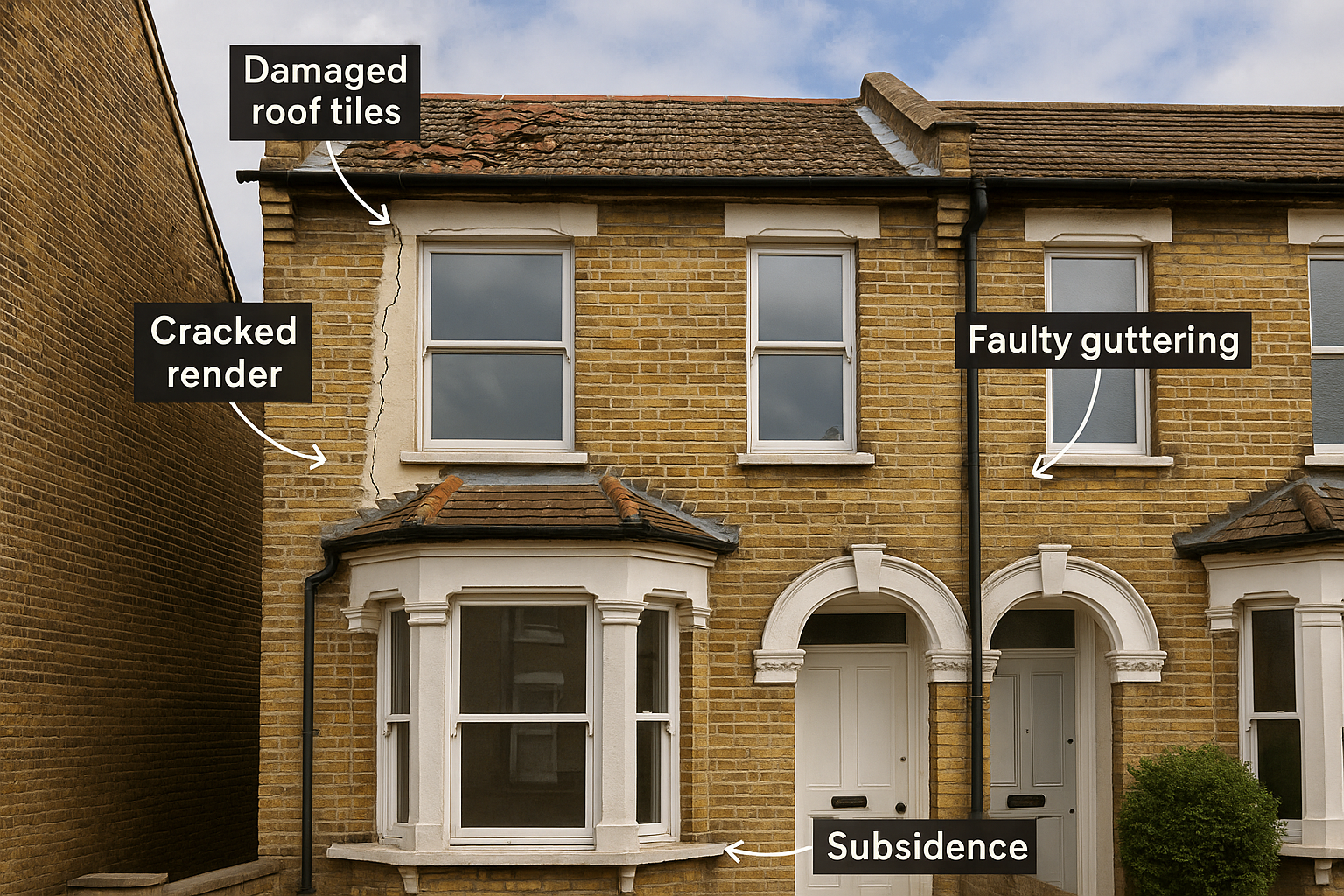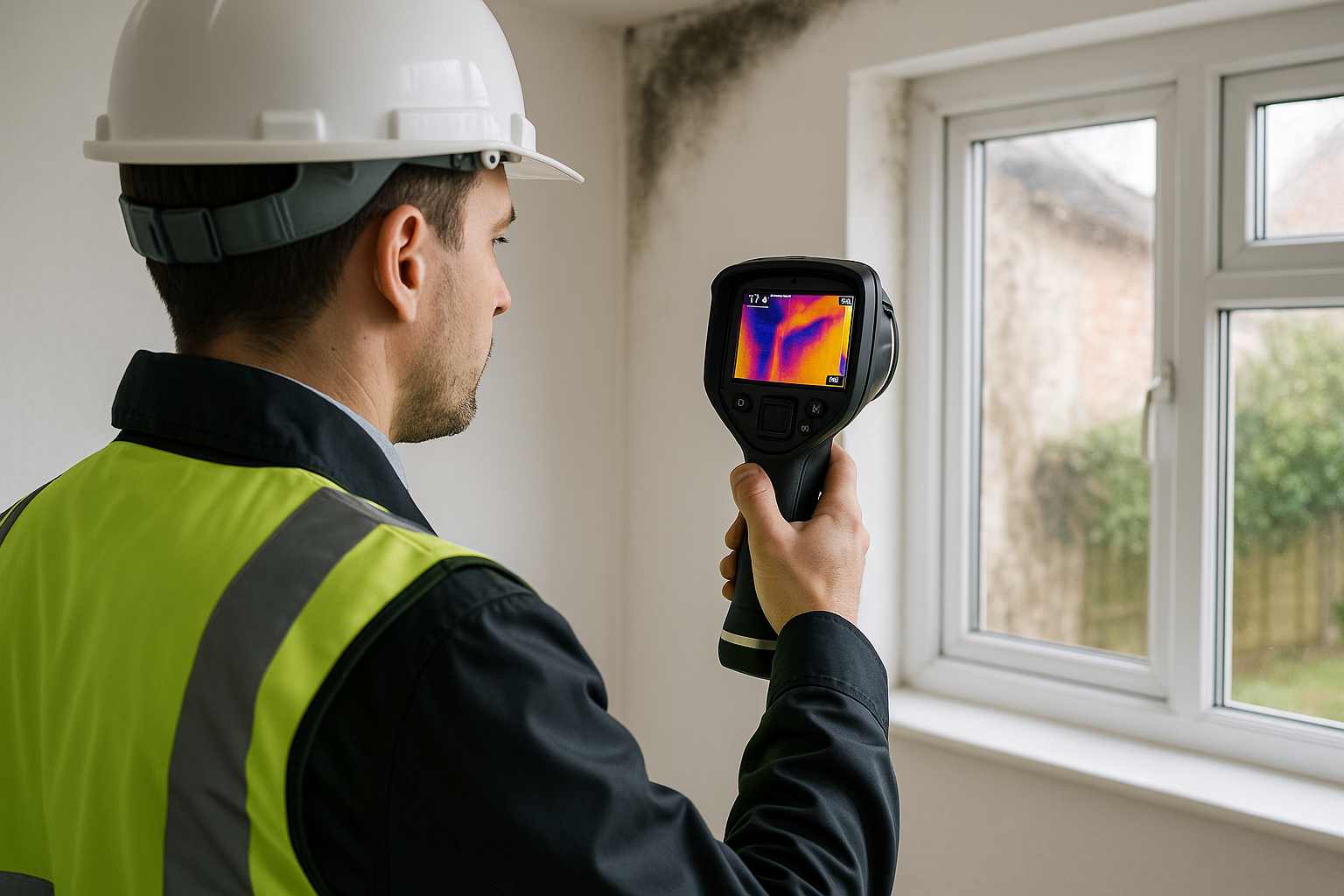Victorian and Edwardian properties form the backbone of housing stock across Surrey and South West London, particularly in areas like Surbiton, Kingston, Richmond, and Esher. While these properties offer character, space, and solid construction, they also present unique challenges due to their age, original materials, and construction methods. At Surbiton Surveyors, we regularly encounter specific defects that property buyers and owners should understand.
Understanding Victorian Construction (1837-1901)
Victorian properties were built during a period of rapid technological advancement and urban expansion. Understanding the construction methods and materials of this era is crucial for identifying potential defects and planning appropriate maintenance strategies.

Typical Victorian Construction Features
- Solid wall construction: Typically 225mm (9 inch) solid brick walls without cavity insulation
- Lime mortar: More flexible than modern cement mortars but requiring different maintenance approaches
- Suspended timber floors: Timber joists supported on sleeper walls with airbricks for ventilation
- Natural slate or clay tiles: Original roofing materials with wooden battens and minimal underlay
- Sash windows: Single-glazed timber sash windows with traditional putty glazing
- Coal-fired heating systems: Original fireplaces and chimney systems designed for coal burning
Structural Defects in Victorian Properties
Structural issues in Victorian properties often stem from the building's age, ground conditions, and changes in use over time. Surrey's geology, with areas of London Clay, adds specific challenges that surveyors regularly encounter.
Subsidence and Foundation Movement
Description: Downward movement of foundations due to ground instability, commonly caused by clay soil shrinkage, tree root activity, or historical mining activities.
Common Signs:
- Diagonal cracks in walls, particularly around windows and doors
- Doors and windows sticking or failing to close properly
- Visible gaps around window frames
- Cracks in internal walls and ceilings
- Uneven floors or skirting gaps
Surrey-Specific Factors: London Clay subsoils are particularly susceptible to seasonal movement. Mature trees common in Surrey neighborhoods (oak, plane, poplar) can cause significant clay shrinkage during dry periods.
Typical Repair Costs: £15,000-50,000 depending on extent and chosen method (underpinning, resin injection, or monitoring)
Wall Tie Failure
Description: In Victorian properties with cavity walls (post-1890s), iron wall ties can corrode and fail, causing structural instability between inner and outer wall leaves.
Identification:
- Horizontal cracks in mortar joints at regular intervals
- Bulging or bowing of external walls
- Rust staining on external brickwork
- Internal wall cracks following wall tie positions
Modern Detection: Metal detection surveys and borescope investigations help identify wall tie condition and distribution.
Repair Solutions: Replacement with stainless steel ties through drilling and resin fixing (£40-60 per m²)
Damp Problems in Period Properties
Damp issues are among the most common defects in Victorian properties across Surrey, often caused by the interaction between original construction methods and modern living requirements.
Rising Damp
Description: Moisture rising from the ground through walls due to absent, failed, or bridged damp-proof courses. Victorian properties often lack effective damp-proofing or have physical DPCs that have deteriorated.
Diagnostic Indicators:
- Tide marks on internal walls typically up to 1.2m height
- Salt deposits (efflorescence) on wall surfaces
- Peeling wallpaper and paint at low level
- Musty odors and potential mold growth
- Damaged skirting boards and floor coverings
Professional Assessment: Electronic moisture meters, salt analysis, and carbide testing provide accurate diagnosis distinguishing rising damp from other moisture sources.
Treatment Options:
- Chemical DPC injection: £200-300 per linear meter
- Physical DPC insertion: £300-500 per linear meter
- External waterproofing systems: £400-800 per linear meter
Penetrating Damp
Description: Moisture penetration through solid walls, particularly common in Victorian properties with 225mm solid brick construction lacking cavity protection.
Common Causes in Surrey Properties:
- Deteriorated lime mortar pointing allowing water ingress
- Cracked or spalled brickwork from freeze-thaw cycles
- Faulty or inadequate external drainage systems
- Ground level raised above DPC level during landscaping
- Damaged render systems applied to solid walls
Solutions: Repointing with appropriate lime mortars, external wall treatment, improved drainage, and breathable external insulation systems.
Roofing Issues in Victorian Properties
Victorian roofs, typically covered with natural slate or handmade clay tiles, present unique maintenance challenges due to material age and changing weather patterns.

Slate and Tile Deterioration
Description: Original Welsh slate and clay tiles can fail after 100+ years due to weathering, thermal movement, and nail corrosion.
Common Failure Modes:
- Delamination of natural slate due to frost action
- Corrosion of iron nails causing slate slippage
- Cracking from thermal stress and building movement
- Missing tiles from storm damage or maintenance access
- Deteriorated mortar bedding allowing water penetration
Assessment Considerations: While individual slate replacement is possible, properties often reach a point where complete re-roofing becomes more economical than ongoing piecemeal repairs.
Cost Implications:
- Individual slate replacement: £15-25 per slate
- Partial roof renewal: £80-120 per m²
- Complete re-roof with matching materials: £120-180 per m²
Roof Structure Deterioration
Description: Victorian roof timber can suffer from woodworm, rot, or structural overloading, particularly where modern insulation has been added without consideration of ventilation requirements.
Inspection Points:
- Purlin and rafter condition in accessible roof spaces
- Evidence of woodworm activity (flight holes and frass)
- Wet or dry rot in timber elements
- Adequate ventilation around modern insulation
- Structural adequacy for modern loads (tanks, solar panels)
Services and Utilities in Victorian Properties
Original Victorian properties predate modern utilities, so electrical, plumbing, and heating systems are typically later additions requiring careful assessment.
Electrical System Concerns
Common electrical issues include:
- Obsolete wiring systems: Lead-sheathed cables, rubber insulation, or early PVC systems
- Inadequate earthing: Original installations lacking modern earthing requirements
- Insufficient capacity: Consumer units designed for lower electrical loads
- Non-standard installations: Historical modifications not complying with regulations
Plumbing and Heating Challenges
Victorian plumbing systems often combine original features with modern additions, creating potential compatibility issues:
- Lead supply pipes: Health concerns and potential for lead contamination
- Cast iron drainage: Corrosion and blockage in underground drainage systems
- Mixed pipe materials: Galvanic corrosion where different metals connect
- Inadequate heating systems: Undersized radiators for solid wall properties
| Defect Category | Typical Cost Range | Urgency Level | Impact on Property Value |
|---|---|---|---|
| Subsidence (minor) | £15,000-30,000 | High | 10-20% reduction |
| Rising Damp Treatment | £5,000-15,000 | Medium | 5-10% reduction |
| Complete Rewiring | £8,000-15,000 | High (safety) | 2-5% reduction |
| Roof Renewal | £15,000-35,000 | Medium-High | 8-15% reduction |
| External Repointing | £8,000-20,000 | Medium | 3-7% reduction |
Window and Door Issues
Victorian properties typically feature timber sash windows and panel doors that require specialized maintenance and repair techniques.
Sash Window Defects
Original sash windows are valuable features but commonly suffer from:
- Sash cord failure: Traditional rope cords deteriorate requiring replacement
- Timber decay: Bottom rails particularly susceptible to wet rot
- Glazing compound failure: Putty deterioration causing loose glazing
- Hardware wear: Sash fasteners, pulleys, and weights require maintenance
- Draught proofing: Poor sealing affects thermal performance
Modern Adaptations and Their Challenges
Many issues in Victorian properties arise from inappropriate modern modifications that conflict with original construction methods.
Insulation Problems
Retrofitting insulation to solid wall Victorian properties requires careful consideration:
- Interstitial condensation: Insulation without vapor barriers can cause condensation within wall construction
- Thermal bridging: Incomplete insulation creating cold spots and condensation
- Ventilation conflicts: Insulation reducing natural ventilation causing humidity problems
- Historic fabric damage: Inappropriate insulation methods affecting building fabric
Conversion Issues
Converting Victorian houses into flats or adding modern facilities can create structural and building control challenges:
- Structural alterations: Removing walls without adequate structural consideration
- Fire safety compliance: Meeting modern escape route and compartmentation requirements
- Sound insulation: Achieving adequate acoustic separation between units
- Services distribution: Installing modern services without damaging historic fabric
Professional Assessment Recommendations
At Surbiton Surveyors, we recommend comprehensive Level 3 Building Surveys for all Victorian and Edwardian properties. Our surveyors use modern diagnostic tools including thermal imaging, electronic moisture meters, and structural monitoring equipment to provide accurate assessments of building condition and defect significance. Early identification of defects enables informed purchase decisions and effective maintenance planning.
Maintenance Strategies for Victorian Properties
Successful Victorian property ownership requires understanding traditional materials and appropriate maintenance approaches that respect original construction methods while meeting modern performance requirements.
Preventive Maintenance Priorities
- Regular roof inspections: Annual checks for loose slates, blocked gutters, and lead work condition
- Exterior repointing: Using appropriate lime mortars to maintain wall flexibility
- Drainage maintenance: Keeping gutters, downpipes, and drains clear and functional
- Timber treatment: Regular inspection and treatment of structural timbers
- Window maintenance: Annual sash cord and hardware inspection
- Heating system servicing: Ensuring adequate heating for solid wall properties
Appropriate Materials and Methods
Victorian properties perform best when repaired using compatible materials:
- Lime mortars: More flexible than cement mortars, allowing building movement
- Breathable paints: Allowing moisture vapor transmission through solid walls
- Traditional roof materials: Maintaining authentic appearance and performance
- Natural insulation materials: Sheep's wool, cork, and wood fiber systems
When to Seek Professional Advice
Certain defects in Victorian properties require immediate professional assessment to prevent escalation and ensure safety:
Professional Services Available
- Specialist surveys: Structural, damp, or electrical condition assessments
- Monitoring services: Crack monitoring to determine movement activity
- Conservation advice: Appropriate repair methods for listed buildings
- Insurance claims support: Professional assessment for subsidence or damage claims
- Planning and building control liaison: Ensuring compliance with regulations
Conclusion: Informed Ownership of Victorian Properties
Victorian properties across Surrey and South West London offer unique character, generous proportions, and solid construction that, with appropriate maintenance, can provide excellent long-term homes. Understanding common defects and their implications enables informed purchase decisions and effective maintenance planning.
While Victorian properties may require higher maintenance than modern homes, their defects are generally well-understood and treatable using established techniques. The key to successful Victorian property ownership lies in:
- Professional survey and assessment before purchase
- Understanding the building's original construction and materials
- Implementing appropriate maintenance using compatible methods
- Addressing defects promptly before they escalate
- Seeking professional advice for significant issues
At Surbiton Surveyors, our experience with hundreds of Victorian properties across Surrey provides valuable insights into common issues and effective solutions. Whether you're considering purchasing a Victorian property or maintaining an existing one, professional surveyor advice ensures you understand the building's condition and can plan appropriate maintenance strategies.
Victorian properties remain among the most desirable housing stock in Surrey, offering character, space, and adaptability that modern properties often lack. With appropriate survey advice and maintenance planning, these buildings continue to provide excellent homes while retaining their historic character and value.